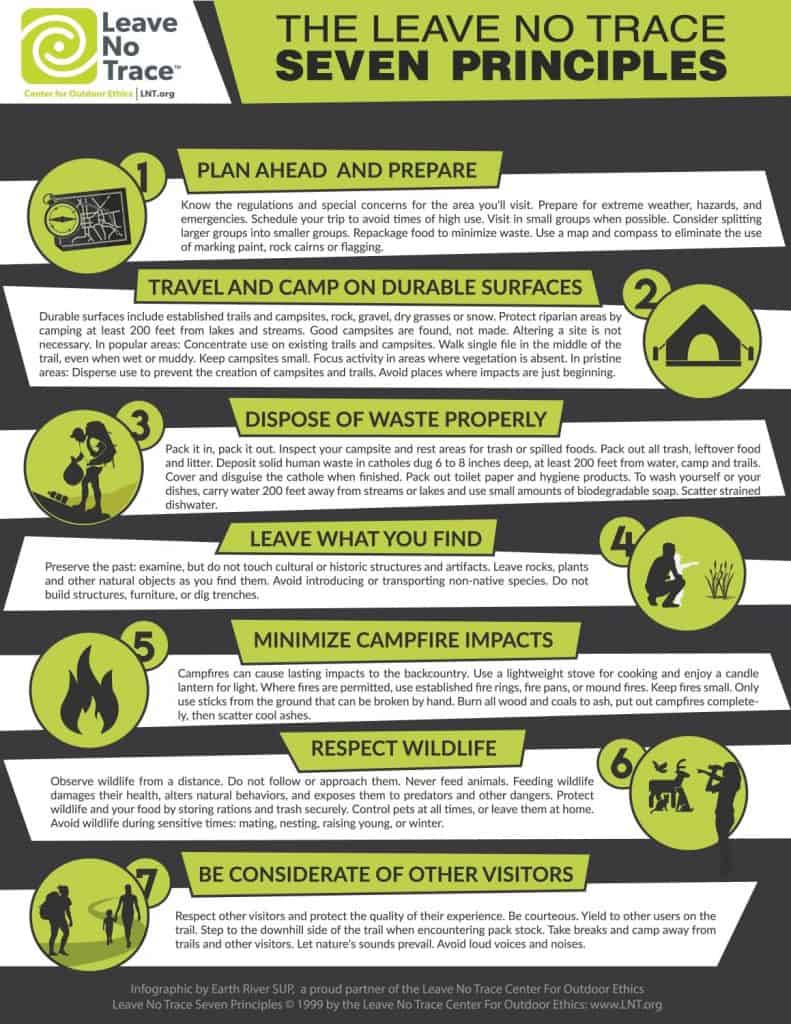Barry and I boondocked on public land last month for the first time. And we fell in love with it! What is not to like – having lots of space, away from people, in nature and it’s free! Or is it? There is a non-monetary cost – our respect and care of the environment around us.
With so many people wanting to get out of the house, there a lot more people are taking advantage of public lands this summer. That is great! But sadly, many are mistreating the privilege and leaving behind trash or worse. We hear from our RV Community that one of the best aspects of RVing is our freedom to see the wonders and beauty of this country. Let’s help make sure it stays free and beautiful by following the principles of Leave No Trace.
Or just remember what your mom and scout leader taught you – leave it better than you found it!

Could Trash Mean Closures?
With COVID and the increased interest in RVs, many people are camping for the first time whether in tents or RVs. We have all noticed the campgrounds and state parks were full this summer and it doesn’t seem to be slowing down. At Sleeping Bear Dunes National Lakeshore on Lake Michigan, July crowds shattered an all-time record, with more than 590,000 visitors. In July 2019, the lakeshore saw just under 500,000.
While folks watch youtube videos and read blogs to learn to drive their rig and use their tank systems, they don’t always take the time to learn the responsible way to preserve the beautiful environments they are visiting. This is leading to reports in increased litter, waste and even graffiti on natural landmarks.
In dispersed campgrounds, people leave behind their trash or dump it on the side of the road assuming there will be a pick up. Then others, seeing this, assume that it is okay and leave theirs too instead of seeking out trash receptacles or packing it out. And even those in campgrounds are often causing issues. Pictured Rocks National Lakeshore in Michigan reported that people are not using the restrooms out of fear of COVID so are defecating next to the building and leaving it out in the open.
As campgrounds fill, people are making their own campgrounds on non designated sites, sometimes parking on sensitive ecosystems like sand dunes. Or they enter dispersed camping areas but go off trails and roads, hurting regrowing vegetation. And they are away from designated camp areas with trash receptacles, so they leave behind trash, coolers, diapers, and other waste. Not only is this gross, but it can cause real issues for animals and people alike!
And while initials carved into the tree might not kill it, it does leave a permanent mark, seems to attract other people to do the same, and ruins the beauty for the rest of us. That mark is probably going to last a lot longer than Johnny and Susie’s love. It is like when we were kids and our moms asked, if she jumped off a cliff, would you do it? NO, we are smarter than that!
With lowered budgets and decreased staffing, the parks cannot keep up. As a result, some organizations like the National Forest Service (NFS) are considering closing some popular camping places and may already shut down some dispersed campsites near Flagstaff, AZ according to our friends at Drivin’ & Vibin’.

Keep Yourself and Wildlife Safe
We were so surprised during our recent trips to the National Parks by the attitudes of visitors who feel comfortable feeding wild animals. Chipmunks are adorable, but on a recent hike to Inspiration Point in the Grand Tetons, I watched them run up to people who pulled out snacks and essentially beg for food. One little girl who wasn’t trying to feed a chipmunk was bitten because in his scramble for food, the animal fell in her lap.
And it isn’t just the small animals. People feel comfortable trying to feed a bear or just leaving out trash that they can get access. A bear in Grand Teton National Park had become so conditioned to people food that it walked into a campsite where a family was staying and took food from their picnic table. When this happens, the bears are euthanized. Just like humans, if there is an easier way, animals will adapt to use it and it cannot be trained to stop.
Studies also show that human food does not have the necessary nutrients that hibernating animals need so hibernation is interrupted, again threatening their existence.
And we have all seen the videos of the tourons (a term I learned from Alex who works in Yellowstone – give it a minute, you will get it!) who get too close to the wild animals, completely sure they are “used to people” in the national parks. No, they are not. This is their home, we are the visitors.
Leave No Trace Guidelines
The National Forest Service and other outdoor agencies ask campers to follow the 7 Principles of Leave No Trace (shown below) which, among other things, asks people to take out what they bring in. While this applies whenever you are boondocking, it is also good practice for any visit to a park or public land. With some simple preparation like carrying ziploc bags to put dog or human waste (and the toilet paper) away safely, we can make a huge difference for our environment.
Basically, the 7 Principles are common sense. So let’s make it more common to do the right thing for our environment and natural world so that we can enjoy it for years to come!

Leave a Reply